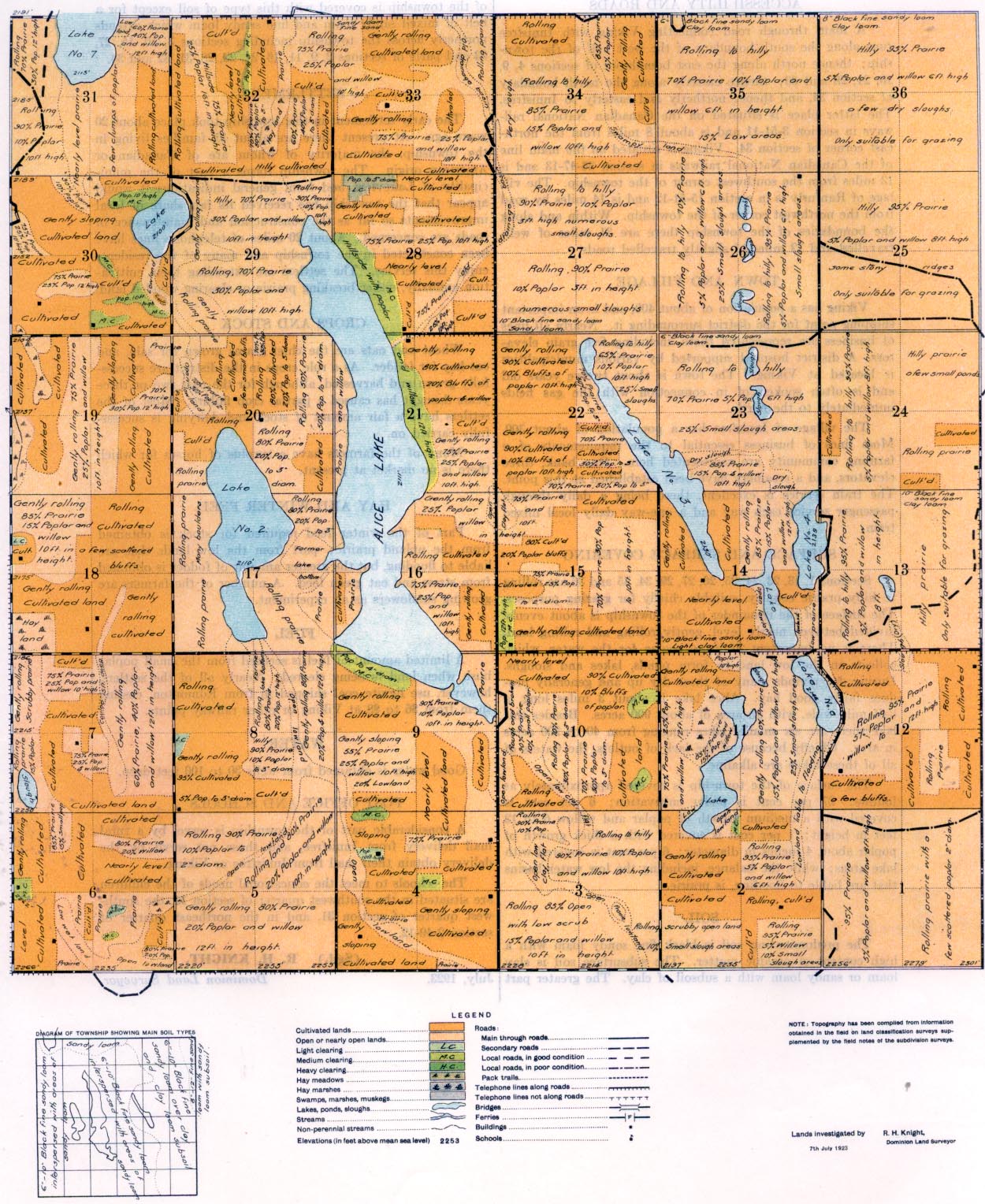
REPORT ON TOWNSHIP 49 Range 11 WEST OF THE FOURTH MERIDIAN
ACCESSIBILITY AND ROADS
A main through road connecting Viking with Innisfree runs along the south boundary of the west half of the township; thence north along the east boundaries of sections 4, 9, 16, 21, 28 and 33; thence easterly along the north boundary ,cf section 34, and thence northerly and easterly to Innisfree. The latter place is situated on the Canadian National rail-! ways in section 3-51-11 and is about 8 miles from the north- east corner of section 34. Viking is situated on the main line of the Canadian National railways in section 36-47-13 and is 13 miles from the southwest corner of the township. The village of Ranfurly is in section 15-51-12 and is 14,miles by road from the northwest corner of the township. Within and along the boundaries of the township there are 31 miles of well travelled and 12 miles of slightly travelled roads.
TOWN AND VILLAGE
Viking has a population of about 400, and is an important shipping point for the district surrounding it. Nearly all lines of business are represented there, including five grain elevators. A district hospital supported by various municipalities is, located at Viking.- The town is about twelve years old and is often spoken of in connection with the gas fields immediately to the north.
The village of Innisfree has a population of about 300. Most lines of business essential to the requirements of a farming community are represented here. One bank, three elevators, and a creamery have been established at this point. The train service is excellent, there
being a daily through passenger service each way and a one-way daily local mixed traim
SURFACE AND SURFACE COVERING
Sections 1, 13, 23, 24, 25, 26, 27, 29, 34, 35 and 36 are rolling to billy prairie country, suitable chiefly for grazing purposes. The surface of the remainder of, the township is about evenly divided between nearly level, gently rolling and rolling land. There is no important drainage course for the water, which collects in the low land to form ponds, lakes and sloughs. During dry periods, many of these dry up and generally pro- duce fairly good hay. A-lice lake is about 3 miles long, a half mile wide, with an area of about 900 acres. Besides this lake there are six smaller lakes ranging from 40 to 200 acres in area. Chiefly because of the lack of outlets, the waters of all of these lakes are alkaline.
The surface of the township is covered approximately as follows: 27 per cent is under cultivation; 6 per cent is covered with a medium growth of poplar and willow 6 to 12 feet in height; I per cent is covered with a thick growth of poplar about 4 inches in diameter; 6 per cent is covered with lake areas; while the balance, including the low water basins that are liable to flooding, is prairie.
SOIL
The predominating soil is black fine sandy loam with a high content of organic matter. The subsurface soil is clay loam or sandy loam with a subsoil of clay. The greater part
of the township is covered with this type of soil except for a belt of mixed sandy loam and fine sandy loam which extends northerly across the township including sections 3, 10, 15, 27, 33 and parts of sections 2, 9, 11, 16, 21, 22, 28, 31, 32 and 34.
SETTLEMENT
The early settlement in this township took place about 20 years ago. At present there are about 35 families living in the township, the majority of Whom are of Canadian or American origin. The township forms a part of the municipality of Lakeview, and from general indications it would appear that the township has received its fair share of local improvements so far as the construction and maintenance of roads are concerned. About 20 miles of telephone lines have been constructed in the township and many of the residents enjoy this Service. The settlers are extending their cultivation annually, either breaking prairie or clearing wooded land.
CROPS AND STOCK
Wheat and oats are the chief grains grown for sale, and eat hay for fodder. As a rule crops in the district are successfully grown and harvested, although for the past two or three years drought has caused a partial crop failure. Most of the settlers have a fair amount of stock and dairying is successfully carried on.
Many of the farmers have a surplus of horses for which there is no market at present.
HAY AND WINTER FEED
Part of the winter feed required for stock is obtained from the upland prairie; part from the low lands that are liable to flooding, but the greater amount of fodder is obtained from straw and oat green feed. A number of the farmers are growing sunflowers as an experiment.
FUEL
A limited amount of fuel'is secured from the small poplar bush when land is being cleared. Nearly all of the settlers, however, use lignite coal shipped in from Edmonton, costing them from $6 to $8 at Viking or other railway points.
WATER
Good water is obtained from wells 30 to 100 feet deep.
POST OFFICE AND SCHOOLS
A considerable part of the township is served by a rural mail delivery from Innisfree, and those not served by the delivery obtain their mail from Innisfree or Viking.
The schools to meet the educational needs of the children are situated in the southwest quarter of section 11, the south- west quarter of section 31, and in the northeast quarter of 5ection 2-49-12.
July, 1923.
(Sgd.)
R. H. KNIGHT,
Dominion Land Surveyor.



